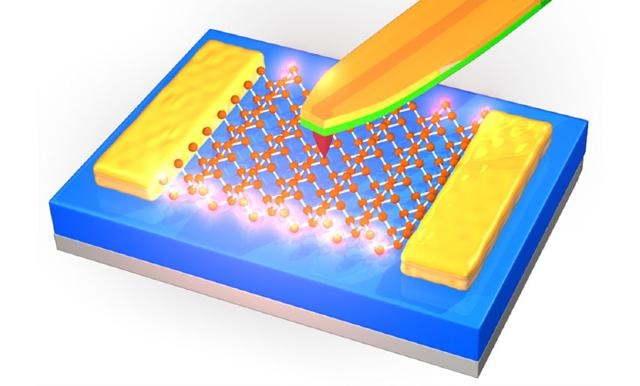Jul 19 2016
A team of physicists keen to enhance the tech gadgetry of the next generation have succeeded in getting the very first glimpse of what happens inside an atomically thin semiconductor device.
 In this visualization of what happens inside a 2-D transistor made of a promising new material called MoS2, electric currents appear initially at the outer edges and then inside of the device. Thread-like flaws can be seen in the interior part of the transistor. (CREDIT: The University of Texas at Austin)
In this visualization of what happens inside a 2-D transistor made of a promising new material called MoS2, electric currents appear initially at the outer edges and then inside of the device. Thread-like flaws can be seen in the interior part of the transistor. (CREDIT: The University of Texas at Austin)
The team from The University of Texas at Austin discovered that one important function for computing may be possible within a small space that is one-dimensional.
On July 18, the Proceedings of the National Academy of Sciences published a paper where the physicists demonstrate their observation of the inner workings of a new two-dimensional transistor model.
Transistors are significant building blocks for computer chips as they supply the electrons with on and off switches that are essential for computer processing. Experts have now started to explore new semiconducting materials such as molybdenum disulfide (MoS2) in order to identify a new method that will help to fit more transistors on computer chips. Transistors developed from the new material enable signaling on a single flat plane unlike the currently used silicon-based devices.
In this visualization of what happens inside a 2-D transistor made of a promising new material called MoS2, electric currents appear initially at the outer edges and then inside of the device. Thread-like flaws can be seen in the interior part of the transistor. (Credit: The University of Texas at Austin)
Headed by Keji Lai, an assistant professor of physics, the team discovered that this new material enables the conductive signaling to take place in a different manner than with silicon. The signaling helps to promote the aspect of saving energy in devices.
Imagine silicon transistors as light bulbs: The device is either switched off or on at once. Compared to 2-D transistors, the team observed that electric currents travel in a more phased manner, starting at the edges before appearing in the interior. Lai states that this highlights the possibility of sending the same current with less power and in a much smaller space using a one-dimensional edge instead of a plane that is two-dimensional.
In physics, edge states often carry a lot of interesting phenomenon, and here, they are the first to turn on. In the future, if we can engineer this material very carefully, then these edges can carry the full current. We don’t really need the entire thing, because the interior is useless. Just having the edges running to get a current working would substantially reduce the power loss.
Kenji Lai, Assistant Professor of Physics, University of Texas
Research to observe the interior workings of a 2-D transistor has been going on for years in order to enhance the understanding of both the limitations and the potential of the new materials. It will take many more years for 2-D transistors to be used in commercial devices, such as cellphones and paper-thin computers. Lai points out that scientists require more information about what hampers with performance in those devices developed from the new materials.
These transistors are perfectly two-dimensional. That means they don’t have some of the defects that occur in a silicon device. On the other hand, that doesn’t mean the new material is perfect.
Kenji Lai, Assistant Professor of Physics, University of Texas
A microscope invented by Lai that points microwaves at the 2-D device was used by his team. The microwave microscope used a tip that was only 100 nanometers wide and enabled the scientists to view the conductivity changes happening inside the transistor. The scientists were thus able to see the motion of the current and they were also able to detect thread-like defects in the middle portion of the transistors. Hence, according to Lai, it is essential for the new material to be made cleaner to enhance its functionality.
“If we could make the material clean enough, the edges will be carrying even more current, and the interior won’t have as many defects,” Lai says.
The paper’s other authors are postdoctoral researchers Di Wu and Xiao Li; research scientist Lan Luan, and graduate students Xiaoyu Wu and Zhaodong Chu, and professor Qian Niu in UT Austin’s Department of Physics; and graduate student Wei Li, former graduate student Maruthi N. Yogeesh, postdoctoral researcher Rudresh Ghosh, and associate professor Deji Akinwande of UT Austin’s Department of Electrical and Computer Engineering.
The Presidential Early Career Awards for Scientists and Engineers, which is the U.S. government's highest honor for early-stage scientists and engineers, was given to both Akinwande and Lai earlier this year.
The research was supported by the National Science Foundation, the Office of Naval Research and the U.S. Department of Energy.